The origins of the Olympics’ obscure track and field events
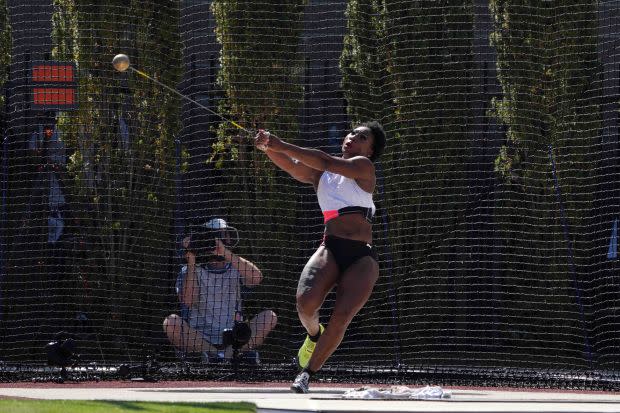
The events of track and field exemplify the traditional Olympic motto of citius, altius, fortius, or “faster, higher, stronger.” Running fast, jumping high, and throwing objects a long way are elemental human pursuits at the core of many other sports like soccer, football, and basketball. Track and field strips these skills down and renders them in their purest form. Their appeal lies in their simplicity.
How, then, do we explain the odd set of maneuvers required of the triple jump?
While the glamor events of track—the 100 meter dash, the 1,500 meter run, the marathon—need no explanation, some of the more esoteric events can puzzle even longtime Olympics watchers. Among them are the triple jump, the pole vault, the steeplechase, and the hammer throw.
These events are often contested off-camera, their medalists known only to the most diehard fans. How they became part of the Olympic program, and why they remain in the games, has much to do with track and field’s central role in the history of the Olympics.
The origins of modern track and field
Like many sports, track and field evolved organically and only became organized in the 19th century, when the US and Europe began to get serious about leisure activities. Over time, races held at fairs and on village greens became more formal, and distances became standardized. English schools held running contests, and Oxford and Cambridge held the first collegiate meet in 1864. Pedestrianism—long distance walking contests that took place over many days, with huge crowds—enjoyed a flurry of popularity in the 1870s and 1880s. Betting was widespread, and the sport developed its first professionals, the runners and walkers who shared in the winnings with bettors. Elsewhere, throwing contests were popular in Scotland (and remain so, in the modern Highland Games).
In 1896, those various threads were braided together at the first Olympic games, according to track and field historian and podcaster Jesse Squire. Inspired by the games of ancient Greece, Olympics founder Pierre De Coubertin staged a track meet with 12 events, including both sprints and distance running events (and the first marathon), as well as jumps and throws. Two events, the discus and javelin, were added to the games specifically because of their ancient greek origins, and had never been contested in modern times.
In all, 64 men from 10 countries competed. Winners received silver medals, and runners-up got bronze. (Third place got nothing.) The Olympics were pointedly for amateur athletes, to exclude the unsavory gambling elements of pedestrianism, Squire says.
Over the years, new events were added—the hammer throw debuted in 1900, the steeplechase in 1920—and became fixtures in the sport as the Olympic track program came to define modern track and field. At the Tokyo Olympics, nearly 2,000 athletes from 190 countries are expected to compete in 48 men’s and women’s events.
What’s the origin of the triple jump?
The triple jump might be considered the first modern Olympic event, since the first medal awarded at the 1896 games went to event champion James Connolly of the US. In the 19th century, jumping was a popular sport. Along with the long jump, high jump, and triple jump—all of which were contested in the 1896 Olympics and survive through today—other events included the standing long jump and the standing high jump (which briefly appeared in later Olympics), in which athletes don’t take a running start.
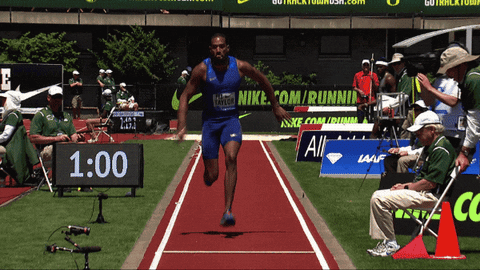
Hop, skip, and jump.
Also called the “hop, skip, and jump,” the modern triple jump requires athletes to take off and land on one leg (the hop), then take off again and land on the other leg (the skip), before jumping into the sand pit. The best in the world travel nearly 60 ft in three steps. In the first Olympics, Connolly won with a “hop, hop, and jump” technique, but by 1900 the event was standardized into its modern form.
What’s the origin of the pole vault?
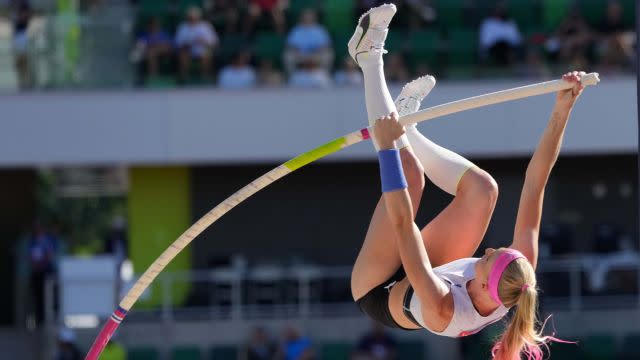
Overcoming obstacles.
Poles were often used to traverse canals and streams in northern Europe. Instead of bridges, a stack of poles allowed travelers to swing themselves over an obstacle. The activity evolved into a sport and pole vaulting for both height and distance was contested in the UK, Germany, and Netherlands. Pole vaulting for distance never made into the Olympics, and is therefore not a part of modern track and field, but it is still a regional sport in the Netherlands, where it is called fieflijeppen (and it is something to behold).
Initially, pole vaulters used stiff poles made of bamboo or aluminum, but with the introduction of flexible fiberglass poles in the 1950s, greater and greater heights were achieved (the mens world record is now 6.18 meters, or 20 ft, 3 in). The women’s pole vault became an Olympic event in 2000. “Pole vaulting,” says Squires, “requires tremendous athletic ability and complete insanity.”
What’s the origin of the hammer throw?
The hammer throw dates back as far as the ancient Irish Tailteann games, where contestants would compete at throwing various heavy objects, including blacksmith hammers. As with other throwing sports, the hammer’s weight became fixed and it eventually evolved from an actual hammer to a heavy ball with a rigid handle to its present form: a steel ball attached to grips with a wire. The men’s hammer weighs 16 lbs (7.26 kgs); the women’s is 8.8 lbs (women didn’t throw the hammer in the Olympics until 2000). The Scottish highland hammer throw still uses a ball attached to a fixed rod.
The hammer can be captivating to watch, as contestants violently whirl around in tight circles, on the brink of losing control, before letting fly.
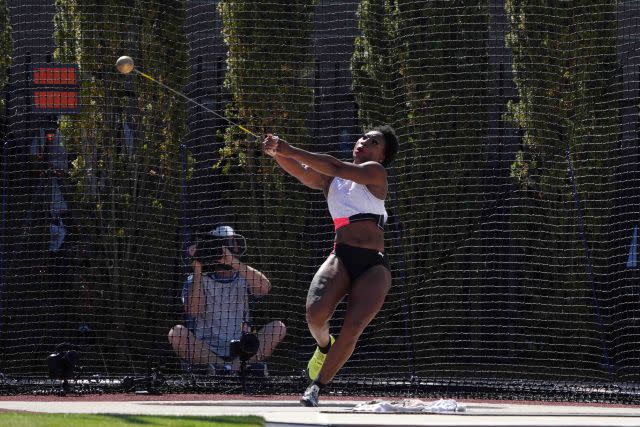
Hammer time.
What is the origin of the steeplechase?
While most distance races are pretty straightforward, the 3,000-meter steeplechase is the peculiar exception. Runners compete over seven and a half laps, jumping over 28 fixed barriers—unlike flimsy hurdles, these don’t give when hit. Most strangely, each lap also includes a water obstacle. While most runners can emerge with just one wet shoe, occasionally some poor runner tumbles in.
The steeplechase takes its origins from 18th- and 19th-century cross country racing in the UK and Ireland, which was contested by both runners and horseback riders. (The name comes from riders racing from the church steeple of one town to another). Steeplechase runners would jump over walls and ford streams. When the event was later contested on a flat ground and run in laps, those obstacles were replicated.
The steeplechase is another Olympic event where women were only recently added, with the first race in 2008.
Both men and women’s steeplechase are dominated by Kenya. Kenyan men have won 22 total medals in the event (Finland, the runner up, has nine), while its women have won two silvers and a bronze.
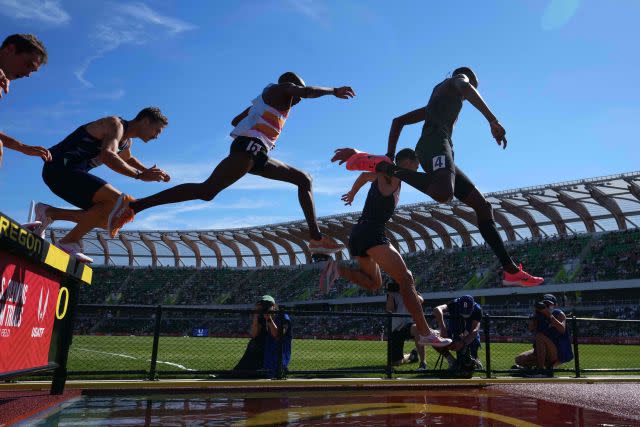
Running wild.
What is the future of these events in the Olympics?
Unlike the 100-meter dash and long jump, which need little or no equipment and are universally contested, events like the pole vault, hammer, and triple jump can require expensive equipment, specialized coaching, or are inherently dangerous—or all three together. They are not widely contested, even in wealthy nations.
As more sports are added to the Olympics, it’s reasonable to wonder if they might be casualties to accommodate athletes in more faddish pursuits like breakdancing and rock climbing. It’s something Squire worries about. For decades, track and field’s preeminence at the Olympics was zealously guarded by Italy’s Primo Nebiolo, the autocratic and ethically flexible head of track’s governing body, Squire says. Its present head, the UK’s Sebastian Coe, may not be as willing to fight dirty to protect track.
Ultimately, Squire says, the solution might be cutting down the number of athletes in each event. Currently, each one has from 24 to 80 qualifiers. Making it harder to get into the games might be the ticket to ensuring all events, even the most obscure, remain in place.
Sign up for the Quartz Daily Brief, our free daily newsletter with the world’s most important and interesting news.
More stories from Quartz:
These are the countries where the delta variant of Covid-19 is now dominant
Why the US can’t just beam internet into authoritarian states like Cuba

